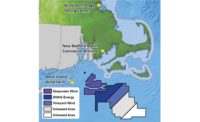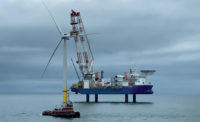A remnant of New England’s coal-fired past came crashing down on April 27, when two, 500 ft cooling towers were demolished in Somerset, Mass. It took 10 seconds and cost $1 million to reduce to rubble the towers that cost $600 million and took four years to build.
It will take another three months to crush the rubble left from the towers and spread it across the 308-acre lot where it will be used as the base for the repurposed site.
The 1,530-MW Brayton Point plant, commissioned in 1963, was the largest coal-fired plant in New England and the last coal plant in Massachusetts.
At one point, coal fueled about 25% of Massachusetts’ electric power but fell to about 6% by 2016.
After New England’s electricity market was deregulated in the 1990s, Brayton Point faced an increasingly tough economic environment in New England’s competitive wholesale power market, and the plant became a liability for a succession of owners, passing in 2005 from an affiliate of California utility Pacific Gas and Electric to Dominion Energy of Richmond, Va., which spent billions of dollars adding environmental controls before selling Brayton to private equity firm Energy Capital Partners in 2013.
In 2015, Energy Capital Partners included Brayton Point in a $3.3 billion bundle of generating assets it sold to merchant generator Dynegy, which ran Brayton for two years before shutting it down. Dynegy sold Brayton Point to Commercial Development Co. (CDC) of St. Louis, Mo., for an undisclosed sum. A press report put the price at $8.5 million, citing local deed and tax records, a figure CDC declined to confirm.
“Brayton Point seems like just one more tombstone in a graveyard of old power plants brought down by various factors, not the least of which are lower power prices driven by falling natural gas prices, low to – in some cases – negative demand growth, and increasing renewable energy adoption,” analyst Paul Patterson with Glenrock Associates, says.
CDC is now turning the site into the Brayton Point Commerce Center, which it calls “a world class logistics port, manufacturing hub, and support center” for the offshore wind sector. “It is a milestone in the region’s transition from coal to renewable energy,” CDC spokesman John Kowalik says.
Brayton Point Commerce Center, CDC’s subsidiary for the new venture, has yet to sign an agreement with a new tenant but is in negotiations with several companies, Stephen Collins, executive vice president of CDC, says.
Collins says CDC could issue a request for proposals for contractors to work on the new facilities as soon as this July. Demolition work at Brayton Point began in September 2018 and is expected to be completed later this year.
Given the transmission constraints and local opposition renewable energy projects often face in New England, offshore wind has become one of the more viable options to meet the region’s renewable policy goals. Massachusetts alone has a target calling for 3,200 MW of offshore wind by 2035, although the 30 MW Block Island wind farm is the only operational offshore wind farm in the United States.
“It is an Incredibly exciting time for an industry that has been dormant for a decade,” Bruce Hamilton, a director at consulting firm Navigant, says. “There is a huge growth opportunity for the entire supply chain.”
Meanwhile, coal plants continue to fall. Nationwide, consulting firm Navigant predicts that 46,600 MW of coal plants could retire by 2028, with 1,000 MW of those plants in New England.
CDC sees opportunity in that trend. “This is the fifth power plant we’ve done in the last five years,” says Collins. The company is repurposing coal plants in Ohio, Michigan and Missouri. “We are bidding on a power plant every day. We probably have bids out on 20 plus projects."





Post a comment to this article
Report Abusive Comment